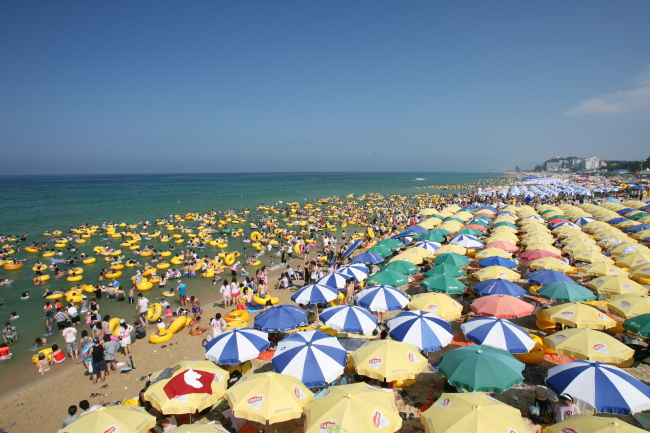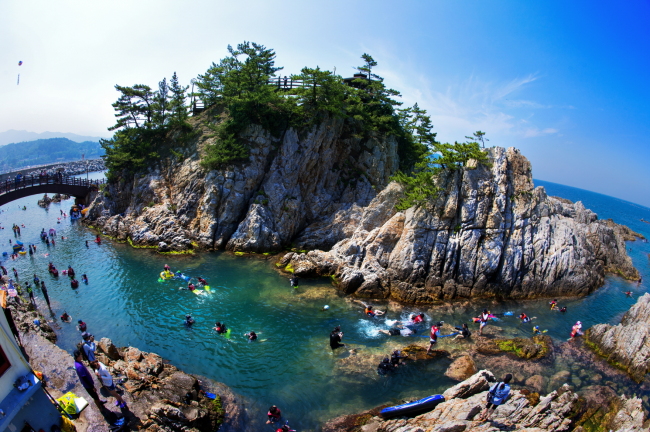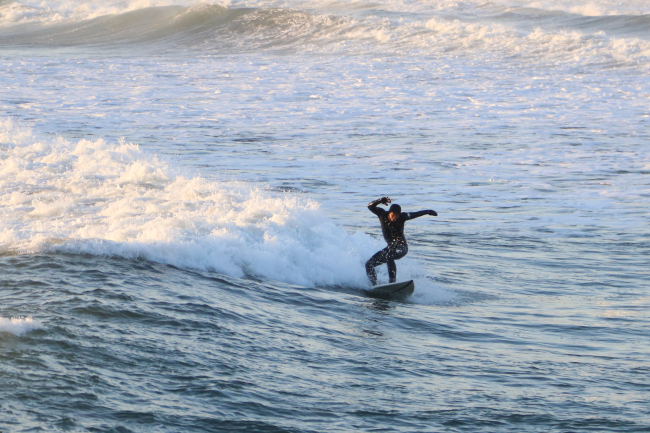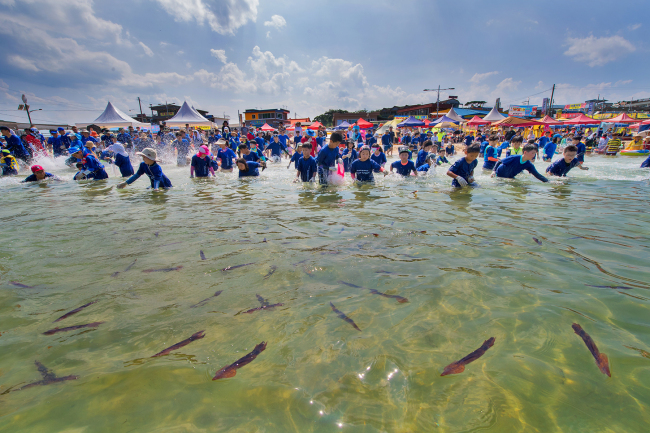[Weekender] Four beaches to check out on east coast
By Ock Hyun-juPublished : July 21, 2017 - 16:14
Beaches along the East Sea draw vacationers for their soft sand and clear water. Below are The Korea Herald’s top four picks to check out this summer.
Gyeongpo Beach, the biggest on East Sea

With a sand beach stretching some 6 kilometers, Gyeongpo Beach is a sand bank located between the East Sea and Gyeongpo Lake. It is the biggest beach along the east coast, attracting an average 6.5 million people each summer.
Located in Gangneung, Gangwon Province, the beach offers fine powdery sand and a variety of activities such as banana boat riding, water skiing and personal watercraft rental. Just a few minutes away lie a vast lake and fine forest where beachgoers can take a respite.
“We came here to refresh ourselves. I am impressed by the emerald green waters,” said Moon Su-young, a 26-year-old office worker who was taking photos at the beach.
Many tourists choose Gyeongpo Beach as a base to start their journey around the eastern coastal line because it is conveniently an established tourist beach with various options for accommodations and restaurants.
It is also close to popular historical sites such as Ojukheon, birth home of prominent Confucian scholar Yulgok Yi I and his mother Sin Saimdang, as well as other sought-after beaches such as Anmok Beach, famous for its nearby coffee street, and Sageunjin Beach, frequented for kitesurfing.
“We had cold raw fish soup in Sokcho and drove along the coastline to have a cup of coffee at a cafe along the beach. It is trendier here with a lot of young people,” said Lee Hyun-sun, 29, at Anmok Beach.
The Gyeongpo Summer Music Festival kicks off for a seven-day run from July 31, which will turn the area into a beachside club with a string of performances every evening from 7 p.m.
Jangho Port, Naples of Korea

Touted as the “Naples of Korea” for its exotic views, Jangho Port in Samcheok, Gangwon Province, is where friends and families are often spotted paddling around in transparent plastic kayaks or snorkeling about to explore the abundant marine life.
The crystal-clear, shallow and calm water makes it one of the country’s rare spots suitable for snorkeling, a popular activity Koreans often seek out on tropical islands in Southeast Asia.
The price for a 30-minute ride for four people in a canoe is 44,000 won ($39), and a snorkeling session for an hour is 11,000 won.
Tourists can also spend a day fishing on a boat, available upon an advance booking.
Only three minutes away by car is Samcheok Ocean Railbike, a must-do attraction for tourists seeking to get a striking view of the East Sea through pine tree forests and tunnels. It is a 5.4-kilometer ride by a four-wheeled rail bike, which takes an hour and runs six times a day during peak season.
Near Jangho Port are large, ancient caves, including Hwanseon cave, which is believed to be the nation’s largest. It is designated Natural Monument No. 178 and is thought to have been formed 530 million years ago.
Jukdo Beach, mecca for surfers

Despite being surrounded by the sea on three sides, South Korea has yet to match the US or Philippines in the number of surfers seeking thrills on the waves.
But Jukdo Beach in Yangyang, Gangwon Province, is emerging as a mecca for local surf lovers, from office workers taking time off work to hard-core enthusiasts.
With a pristine 2-kilometer stretch of sand beach and a lush pine forest surrounding it, Jukdo now draws as many as 200 surfers a day.
Park Joon-young, who owns one of the surf shops sprawled along the Jukdo shoreline, said the beach offers waves the right size and speed for experienced surfers.
“It’s just a perfect place to surf. And it only takes about two hours from Seoul with the new highway opened,” he said.
To catch the biggest waves, it is best to come in fall or winter, Park said.
In summertime, when the waves are not so big, beginner surfers come here, borrow surfboards, fins and wetsuits and take surf lessons, he added.
“Jukdo’s shallow waters make it ideal for stronger waves. That’s among the reasons for the increasing popularity of surfing here,” another surf shop owner said.
The beach is also packed with eateries, pubs and camping sites in the pine forest nearby, making it a place for vacationers seeking a retreat to the country’s scenic east coast.
Songjiho Beach for family, fun-loving vacationers

Songjiho Beach, located in Goseong County, Gangwon Province, some 200 kilometers east of Seoul, is ideal for family travelers, with 2 kilometers of soft sand and shallow water, plenty of seafood restaurants near the beach and a variety of beachside events taking place all around the year.
The biggest event on the beach’s calendar is the cuttlefish festival.
Scheduled for Aug. 11-12 this year, the festival is expected to attract a large crowd with the fun of trying catch cuttlefish bare-handed near the seashore.
Another attraction of the beach is that it has a vast lake just a few minutes’ walk away — Songji Lake. Blessed with tidal flats rich in marine life, the lake has an approximate circumference of 6.5 kilometers and is surrounded by dense pine forests.
Songjiho Beach is also known for its clear blue water – among the clearest on the eastern coast – and its scenic view of Jukdo Island, right off the beach.
By Ock Hyun-ju and Bak Se-hwan (laeticia.ock@heraldcorp.com) (sh@heraldcorp.com)
-
Articles by Ock Hyun-ju










![[Today’s K-pop] BTS pop-up event to come to Seoul](http://res.heraldm.com/phpwas/restmb_idxmake.php?idx=644&simg=/content/image/2024/04/17/20240417050734_0.jpg&u=)
![[Graphic News] More Koreans say they plan long-distance trips this year](http://res.heraldm.com/phpwas/restmb_idxmake.php?idx=644&simg=/content/image/2024/04/17/20240417050828_0.gif&u=)





![[KH Explains] Hyundai's full hybrid edge to pay off amid slow transition to pure EVs](http://res.heraldm.com/phpwas/restmb_idxmake.php?idx=652&simg=/content/image/2024/04/18/20240418050645_0.jpg&u=20240419100350)

